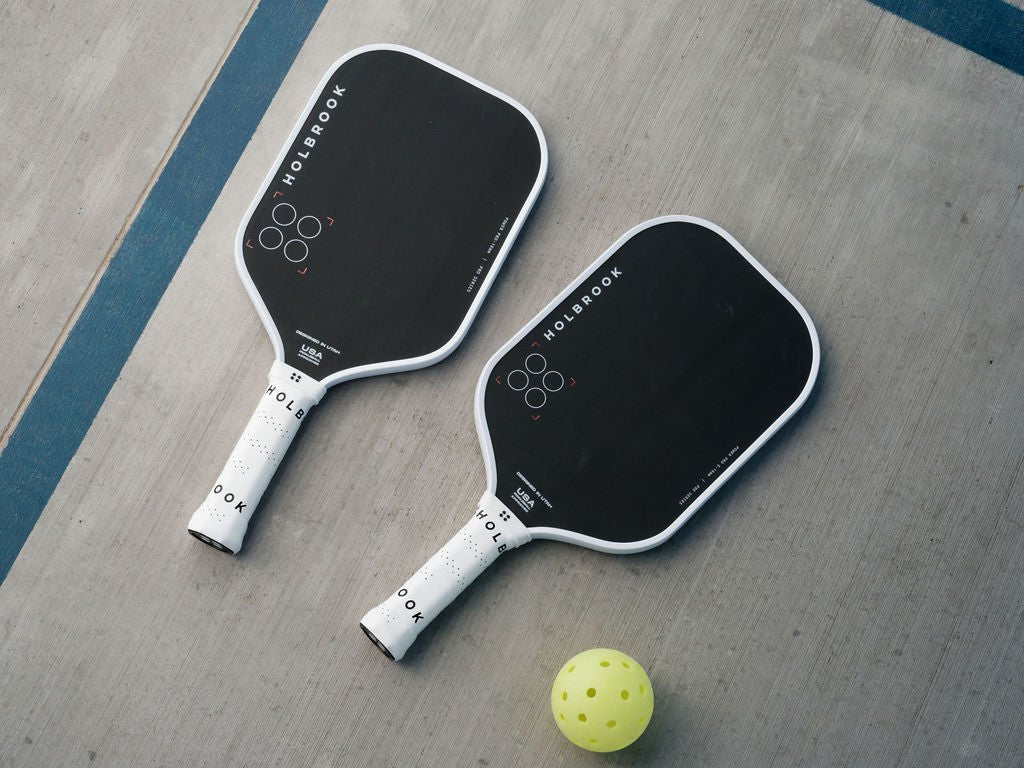Let's talk the difference between pickleball vs tennis
Pickleball
Pickleball was invented in the mid-1960s on Bainbridge Island, Washington, by three fathers – Joel Pritchard, Bill Bell, and Barney McCallum – who were seeking an activity to entertain their children. They improvised the game using ping pong paddles, a plastic ball, and a badminton net. The game was initially dubbed "Paddle Rackets" but was later renamed after the Pritchards' dog, Pickles, who had a penchant for chasing after the ball.
Pickleball combines elements of tennis, badminton, and table tennis, and in recent years has grown in popularity, especially among older players looking for a low-impact, social sport. Today, it has become one of the fastest-growing recreational activities in the United States and has gained international recognition, with dedicated courts and leagues worldwide. It’s easy-to-learn yet challenging nature has made pickleball accessible to people of all ages and skill levels, contributing to its widespread appeal.
Tennis
One of the world's most beloved racket sports, tennis boasts a rich and storied history. Its origins can be traced back to 12th century France, where it evolved from a medieval game called "jeu de paume," meaning "game of the palm." Initially played indoors with hands, players eventually began using gloves and later wooden implements, giving rise to the tennis racket.
The game gained popularity among European nobility and clergy, spreading to England in the 16th century. There, it transitioned from indoor courts to the grassy lawns of country estates, birthing the precursor to modern lawn tennis. The sport's rules and equipment underwent standardization throughout the 19th century, with pivotal contributions from figures like Major Walter Clopton Wingfield, who patented the first commercial version of lawn tennis in 1874.
The All England Lawn Tennis and Croquet Club, founded in 1868, hosted the first Wimbledon Championship in 1877, marking a seminal moment in the sport's history. Since then, tennis has evolved into a global phenomenon, with prestigious tournaments like the French Open, the US Open, and the Australian Open, attracting millions of fans and elite players from all corners of the globe. Its enduring popularity continues to make tennis a cornerstone of the international sports landscape.

Tennis vs Pickleball
It may be easy for your mind to start comparing pickleball and tennis, however, these sports are distinct, each with their own charm and unique appeal.
Tennis, with its long standing heritage and global following, unfolds on a larger court with a felt-covered ball and powerful strokes. It demands a blend of strength, speed, and finesse from its players, requiring strategic placement and deft maneuvering across the court. The game's singles and doubles formats offer a dynamic range of playstyles, from baseline rallies to net-charging volleys.
In contrast, pickleball, a relative newcomer to the world of racquet games, boasts a smaller court, a paddle akin to a large ping pong racket, and a whiffle ball. It emphasizes control, precision, and collaborative play, favoring strategic shot placement over excess force. The game's accessibility, low-impact nature, and ease of learning have endeared it to a wide spectrum of players, young and old.
While tennis epitomizes tradition and athleticism on a grand scale, pickleball thrives on inclusivity, fostering a strong sense of community among its enthusiasts.
Pickleball vs. Paddle Tennis
You might be wondering if pickleball is more similar to paddle tennis.
Paddle tennis and pickleball, though sharing similarities, are distinct in their own right. Paddle tennis, with its roots tracing back to the early 20th century, is a dynamic sport played on a smaller court with solid paddles and a depressurized tennis ball. It demands agility, precision, and swift reflexes from its players. The game's tight quarters foster intense rallies, making it a test of both finesse and stamina.
On the other hand, pickleball, a relatively newer addition to the sports world, gained popularity in the latter half of the 20th century. Played on a smaller court with a unique wiffle ball and a paddle akin to an oversized table tennis racket, pickleball combines elements of multiple sports into a unique game of competition and strategy.
Pickleball emphasizes strategic placement and teamwork, often favoring strategy over sheer power. The game's accessibility and ease of learning have contributed to its rapid rise in popularity, especially among a diverse demographic.
In comparing the two, paddle tennis is a fast-paced, high-energy contest, while pickleball offers a more tactical, inclusive experience for a wide range of people. Both sports, however, share a common thread in promoting camaraderie, competition, and a love for the game. Ultimately, the choice between them boils down to individual preference and the minute by minute experience one seeks on the court.
Pickleball vs Tennis Net Height
The net height in pickleball and tennis stands as a notable point of divergence between these two racquet sports.
In tennis, the net is set at a standard height of 3 feet (91.4 centimeters) at the center and 3.5 feet (1.07 meters) at the posts. This elevation complements the dynamics of the game, allowing for powerful serves, high-arching shots, and net play that demands precision and timing.
On the other hand, pickleball features a lower net, positioned at a height of 36 inches (91.4 centimeters) at the sidelines and 34 inches (86.4 centimeters) at the center. This reduced net height facilitates a style of play that emphasizes control, placement, and volleying, as it's lower than in tennis. The net's lower stance in pickleball accommodates players of various skill levels and physical capabilities, making the sport more accessible to a wider demographic.
Growth of Pickleball vs Tennis
The growth trajectory of pickleball and tennis paints a fascinating picture of evolving sporting preferences.
Tennis, with its established legacy dating back centuries, has long been a staple of the sporting world, boasting a global following and a rich tradition of professional tournaments. However, in recent decades, pickleball has experienced a meteoric rise in popularity. This relatively newer sport has captured the imagination of players of all ages and skill levels.
Its accessibility and ease of learning have been instrumental in its rapid expansion, particularly among both young and older demographics and those seeking a more inclusive, social sporting experience.
While tennis continues to thrive as a premier competitive sport, pickleball's surge in popularity reflects a broader trend towards sports that are approachable, engaging, and foster a strong sense of community. The coexistence and growth of these two sports speak to the diverse tastes and evolving preferences of the sporting world, offering enthusiasts a wide spectrum of options to choose from.
What is the Size of a Pickleball Court Compared to a Tennis Court?
The size differential between a pickleball court and a tennis court is easily noticeable.
A standard pickleball court is roughly a third the size of a tennis court. Specifically, a pickleball court measures 20 feet in width and 44 feet in length, while a tennis court can be as wide as 27 feet for singles and 36 feet for doubles, with a length of 78 feet.
This discrepancy in dimensions significantly impacts the style and pace of play in each sport. The smaller pickleball court leads to quicker, more dynamic rallies, demanding precise placement and rapid reflexes. In contrast, the larger expanse of a tennis court allows for longer baseline exchanges and more extensive movement across the playing area. This distinction in court size is a fundamental factor contributing to the unique character and strategy of each sport.

What is the Scoring System for Pickleball vs Tennis?
The scoring systems in pickleball and tennis are each unique to their respective game.
In tennis, games are typically played to four points, with points being awarded as 15, 30, 40, and then the game point. If both players or teams reach 40, it's referred to as deuce, and a player must win two consecutive points to secure the game.
Moreover, tennis matches are typically composed of sets, and a player must win six games (with a margin of at least two) to claim a set. Ultimately, a player must win a majority of sets, usually two out of three or three out of five, to win the match.
In pickleball, the scoring system is simpler. Games are played to 11 points, and points are scored only by the serving team. The serving team must win a rally to serve, and points can be scored whether they are serving or not. In addition, if the game reaches 10-10, a team must win by a margin of two points to secure the victory. This unique scoring system in pickleball ensures that games are often closely contested, adding an element of friendly competition and excitement to every match.
What is the Difference in the Equipment Used for Pickleball and Tennis?
The equipment used in pickleball and tennis underscores their distinct styles of play. In pickleball, players employ a solid paddle made of materials like wood, composite, or graphite. These paddles are wider than tennis rackets and have a flat, square-shaped hitting surface.
Our recommendation for the ultimate pickleball paddle is the Mav Pro E. A paddle that enhances attacking power, controlled finesse, and adds a cutting spin to your game.
Pickleball uses a lightweight, perforated plastic ball with holes, often referred to as a wiffle ball. This unique ball design ensures controlled play and allows for engaging rallies.
On the other hand, tennis players utilize a strung racket made of materials like graphite, aluminum, or carbon fiber. The strings provide the necessary tension to hit the pressurized tennis ball, which is covered in felt and is considerably heavier than a pickleball.
The differences in equipment not only affect the way the games are played but also contribute to the distinct techniques and strategies that players must employ in each sport. Adaptation to these specialized tools is key to mastering either pickleball or tennis.
What is the Difference in the Rules of Pickleball and Tennis?
We’ve laid out the differences in court size, net height, scoring systems, equipment and overall growth, but there are still a few foundational principles that also reveal differences.
In pickleball, players must serve underhand, whereas in tennis, the serve is typically performed overhand. Additionally, the serve in pickleball must be made diagonally, and the ball must bounce once on each side before volleys are allowed, introducing a unique strategic element.
These nuances, along with other specific rules regarding double bounces, faults, and court positioning, contribute to the individual character and dynamics of each sport. Understanding and adhering to these distinct rule sets is crucial for players to excel in their chosen game.
Core Takeaways in Pickleball vs. Tennis: What's Right for You?
Choosing between pickleball and tennis ultimately comes down to your personal preferences and what you seek in a racquet sport. If you value agility, precision, and intense rallies in a smaller court setting, pickleball might be your game. Its lower net height, unique paddle design, and whiffle ball create a distinctive, fast-paced experience that demands quick reflexes and strategic thinking.
If you're drawn to the grandeur and tradition of a larger court, where powerful serves, baseline rallies, and net play are key, tennis is the classic choice. Its longer matches and sets provide a different level of endurance and mental fortitude.
It’s also important to consider your physical condition and what kind of physical impact you prefer - pickleball is known for being easier on joints due to the lighter ball and shorter court. Both sports offer vibrant communities and opportunities for social play or competitive matches. So, whether you're looking for an inclusive, social experience or a challenging, competitive endeavor, there's a racquet sport out there to suit your taste.





